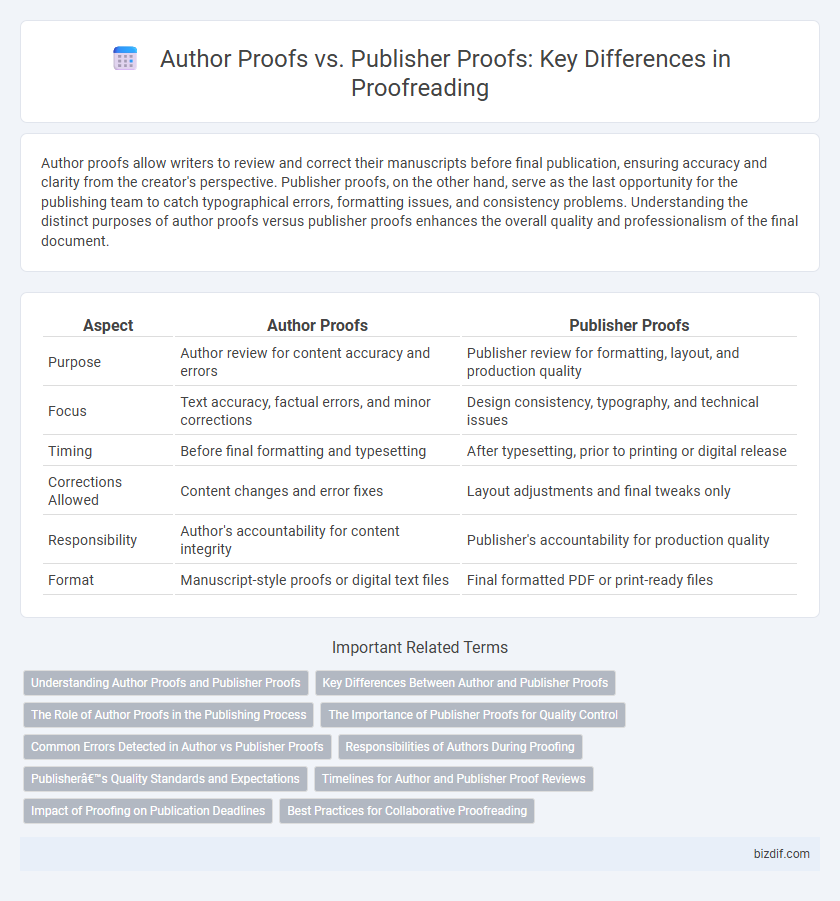Author proofs allow writers to review and correct their manuscripts before final publication, ensuring accuracy and clarity from the creator's perspective. Publisher proofs, on the other hand, serve as the last opportunity for the publishing team to catch typographical errors, formatting issues, and consistency problems. Understanding the distinct purposes of author proofs versus publisher proofs enhances the overall quality and professionalism of the final document.
Table of Comparison
| Aspect | Author Proofs | Publisher Proofs |
|---|---|---|
| Purpose | Author review for content accuracy and errors | Publisher review for formatting, layout, and production quality |
| Focus | Text accuracy, factual errors, and minor corrections | Design consistency, typography, and technical issues |
| Timing | Before final formatting and typesetting | After typesetting, prior to printing or digital release |
| Corrections Allowed | Content changes and error fixes | Layout adjustments and final tweaks only |
| Responsibility | Author's accountability for content integrity | Publisher's accountability for production quality |
| Format | Manuscript-style proofs or digital text files | Final formatted PDF or print-ready files |
Understanding Author Proofs and Publisher Proofs
Author proofs allow writers to review and correct their manuscripts for typographical errors and layout issues before final publication, ensuring content accuracy and authorial intent. Publisher proofs serve as the final verification stage for printers and editors to confirm formatting, design elements, and compliance with publishing standards. Understanding the distinction between author proofs and publisher proofs is crucial for maintaining quality control and preventing costly post-production corrections.
Key Differences Between Author and Publisher Proofs
Author proofs primarily focus on content accuracy, allowing authors to review and correct textual errors, figure placements, and formatting inconsistencies. Publisher proofs emphasize final production details, including typesetting quality, pagination, and adherence to the publisher's style guide. The key differences lie in the scope of corrections permitted, with author proofs enabling content revisions and publisher proofs serving as a last check before printing.
The Role of Author Proofs in the Publishing Process
Author proofs serve as the author's final opportunity to identify and correct errors, ensuring accuracy and consistency before publication. These proofs allow for reviewing content, layout, and formatting, providing a critical checkpoint to maintain the integrity of the manuscript. Timely feedback on author proofs helps streamline the publishing process and reduces the risk of costly post-publication corrections.
The Importance of Publisher Proofs for Quality Control
Publisher proofs serve as the final checkpoint in the publication process, ensuring that formatting, layout, and typesetting adhere to established standards. These proofs allow publishers to identify and correct errors that may have been overlooked during author reviews, such as inconsistent fonts, misplaced images, or missing citations. Maintaining rigorous quality control through publisher proofs significantly enhances the professional presentation and accuracy of the final published work.
Common Errors Detected in Author vs Publisher Proofs
Author proofs often reveal errors in content accuracy, such as factual inaccuracies, inconsistent terminology, and citation mistakes, while publisher proofs typically detect layout issues like font inconsistencies, pagination errors, and image resolution problems. Common errors identified in author proofs also include grammatical mistakes and unclear sentence structures that affect readability. Publisher proofs focus more on production quality, ensuring that formatting adheres to publication standards and that all graphical elements are properly aligned and displayed.
Responsibilities of Authors During Proofing
Authors are responsible for meticulously reviewing author proofs to correct typographical errors, clarify ambiguous wording, and ensure all factual data is accurate before final publication. They must verify references, figure captions, and tables to maintain scholarly integrity and avoid misinterpretation. Publisher proofs primarily involve layout and formatting checks, but the author's detailed content review is crucial to prevent costly post-publication corrections.
Publisher’s Quality Standards and Expectations
Publisher proofs adhere to stringent quality standards, ensuring consistency in formatting, style, and accuracy before final publication. These proofs undergo meticulous evaluation to meet the publisher's expectations for professional presentation and error-free content. Author proofs primarily serve as a last review for content accuracy, while publisher proofs focus on refining overall quality and compliance with specific publishing guidelines.
Timelines for Author and Publisher Proof Reviews
Author proofs typically require review within 24 to 72 hours to ensure timely corrections before final publication. Publisher proofs often have longer timelines, ranging from 5 to 10 days, allowing for comprehensive editorial checks and adjustments. Efficient management of both author and publisher proof review periods is critical to maintaining the overall publication schedule.
Impact of Proofing on Publication Deadlines
Author proofs primarily allow the author to catch errors and suggest final corrections, ensuring content accuracy before publication. Publisher proofs focus on layout, typesetting, and design consistency, with tight deadlines that directly impact the entire publication schedule. Delays in returning either author or publisher proofs can lead to missed publication deadlines, affecting distribution and marketing timelines.
Best Practices for Collaborative Proofreading
Author proofs allow writers to review and correct content before final publication, ensuring accuracy and alignment with their original intent. Publisher proofs focus on formatting, layout, and typesetting errors to maintain brand consistency and production quality. Effective collaborative proofreading integrates clear communication, version control, and defined roles to streamline error identification and resolution, enhancing the overall publication process.
Author Proofs vs Publisher Proofs Infographic

 bizdif.com
bizdif.com